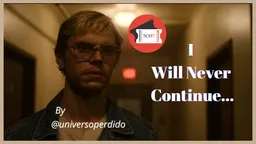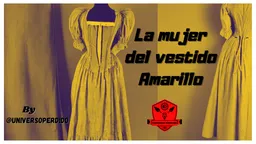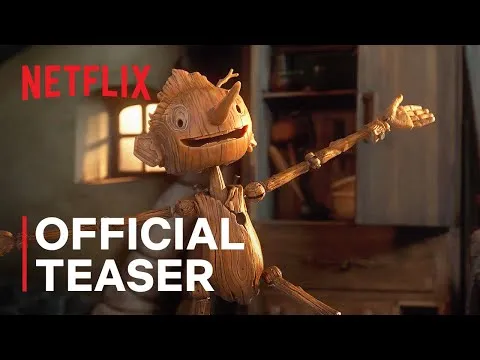
Image edited with Canva



E N G L I S H
Guillermo del Toro is a master of fantasy in cinema, his very particular style for creating stories has a charm that, despite being visually strange and dazzling, is still appropriate for a family audience, since his films are always riddled with iconic and memorable phrases.
Famed for 'Pan's Labyrinth' and 'Hellboy', two movies that made him immensely popular; The first, above all, was the one that made this director famous, earning him several Oscars and other awards. His appearance on Netflix with 'Guillermo del Toro's Cabinet of Curiosities; an anthology of horror stories chosen by Del Toro himself and each adapted by a different director, has sparked great interest and contentment for lovers of the genre.
Again, he dominates the Netflix spaces with his version of Pinocchio; the famous children's tale by Carlo Collodi, which was popularized by Disney thanks to its 1940 animated adaptation. In 2022, a remake of this same version was released, but it did not meet the expectations expected; in addition to adding elements to the story that did not make any positive changes but generated more criticism that ended up destroying Disney's Live Action version.
E S P A Ñ O L
Guillermo del Toro es un maestro de la fantasía en el cine, su estilo tan particular para crear historias, tiene un encanto que, a pesar de ser visualmente extraño y deslumbrante, no deja de ser apropiado para un público familiar, pues sus películas siempre están plagadas con frases icónicas y memorables.
Afamado por ‘El Laberinto del Fauno’ y ‘Hellboy’, dos películas que lo hicieron inmensamente popular; la primera, más que todo, fue quien hizo a este director famoso, valiéndole varios Oscars y otros premios más. Su aparición en Netflix con ‘Guillermo del Toro's Cabinet of Curiosities’; una antología de historias de terror elegidas por el propio Del Toro y adaptadas cada una por un director diferente, ha provocado gran interés y contento para los amantes del género.
Nuevamente, domina los espacios de Netflix con su versión de Pinoccio; el afamado cuento infantil de Carlo Collodi, que fue popularizado por Disney gracias a su adaptación animada de 1940. En el año 2022, fue lanzado un remake de esta misma versión, pero no consiguió las expectativas que se esperaban; además de agregar elementos a la historia que no hicieron ningún cambio positivo, sino que generó más críticas que terminaron por destruir la versión Live Action de Disney.


This same year, Guillermo del Toro decided to launch his version of the story, adapting it to the fascist Italy of World War II dominated by Benito Mussolini. A much more striking scenario and not at all disturbing in a movie for the whole family, because I think that the story was carried out in a good way, with a likable and endearing character in the plot; a little unbearable at first, but charming and funny afterward.
The art of Guillermo Del Toro's Pinocchio is quite a visual delight, like most of this director's films. I liked the cinematographic style in stop motion, the originality and appearance of the main character, and the details that were seen a little more in the background. The added extra elements gave it that touch that was needed and that made everything different; like that particularity of seeing death.
I liked the representation of the Blue Fairy and that of Death; both sisters look like biblical angels or chimeras, and the details of the eyes on their wings are something I had already seen, for example, in Hellboy 2; it could be said that it is already a personal mark of the artist. The quality of the specific aspects made the story more interesting. Whenever I see a Del Toro movie I pay attention to the artistic details; there is so much symbology in them; coming from the mythology of different cultures that were meticulously captured aesthetically.
Este mismo año, Guillermo del Toro decidió lanzar su versión del cuento, adaptándolo en la Italia fascista de la Segunda Guerra Mundial dominada por Benito Mussolini. Un escenario mucho más llamativo y para nada perturbador en una película para toda la familia, pues pienso que la historia se llevó a cabo de buena manera, con un personaje simpático y entrañable en la trama; un poco insoportable al principio, pero encantador y gracioso después.
El arte de Pinoccio de Guillermo Del Toro, es todo un goce visual, como la mayoría de las películas de este director. Me gustó el estilo cinematográfico en stopmotion, la originalidad y aspecto del personaje principal, y los detalles que se veían un poco más al fondo. Los elementos extras que se agregaron le dieron ese toque que hacía falta y que hicieron que todo fuera diferente; como esa particularidad de ver a la muerte.
Me gustó la representación del Hada Azul y la de La Muerte; ambas hermanas con aspecto de ángeles bíblicos o quimeras, los detalles de los ojos en sus alas es algo que ya había visto, por ejemplo, en Hellboy 2; podría decirse que ya es una marca personal del artista. La calidad de los aspectos específicos hacía más interesante la historia. Siempre que veo una película de Del Toro me fijo en los detalles artísticos; hay tanta simbología en ellos; provenientes de la mitología de diferentes culturas y que fueron plasmados estéticamente de manera minuciosa.




The cast was another thing that intrigued me since it is made up of some of the most famous personalities in the world of cinema; like Tilda Swinton, Cate Blanchett, Ron Perlman, Ewan McGregor, David Bradley, and the recent one known for the series 'Stranger Things'; Finn Wolfhard, an acting group that lent their voices to this stop-motion artistic marvel. The roles were more than adequate, I saw the film in its original language and it was more than fantastic; I could only recognize Tilda's voice, more than anything, because Cate Blanchett did the representation of her in a way that I did not expect; giving her voice to the sounds and gestures of a monkey, that is dedication and adaptation to art.
The mechanism and detail to create this type of animation is quite a process, I've always been a fan of stop-motion, and I prefer it more than the usual type of animation. As for the details, I mentioned that the film was set in Mussolini's Italy, a curious setting that generates intrigue and does not stray from the original story sequence.
Pinocchio's story was published long before the domination of fascism, at a time when the industrial revolution and massive Italian immigration predominated, which not only extended into Europe but beyond; to the American continent.
In Del Toro's version, we can see the harsh reality of war; although not in an abrupt and depressive way, when we take a look at the background in detail, we can realize the coldness and severity of 'Il Duce's fascism. The children did not escape this reality and were forced to try even a bit of belligerence, to turn them into real soldiers who give their lives for perverse authoritarianism.
El elenco fue otra de las cosas que me causó intriga, ya que está conformado por algunas de las personalidades más afamadas del mundo del cine; como Tilda Swinton, Cate Blanchett, Ron Perlman, Ewan McGregor, David Bradley y el reciente conocido por la serie ‘Stranger Things’; Finn Wolfhard, un grupo actoral que prestó sus voces a esta maravilla artística del stopmotion. Los papeles fueron más que adecuados, me vi la película en su idioma original y fue más que fantástico; solo pude reconocer la voz de Tilda, más que todo, pues Cate Blanchett hizo su representación de una manera que no me esperaba; dando su voz a los sonidos y gestos de un mono, eso sí que es dedicación y adaptación al arte.
El mecanismo y detalle para crear este tipo de animación es todo un proceso, siempre he sido fan del stopmotion, en verdad que lo prefiero más que el tipo de animación habitual. En cuanto a los detalles, mencioné que la película estaba ambientada en la Italia de Mussolini, un escenario curioso, que genera intriga y que no se sale de la secuencia de la historia original.
El cuento de Pinoccio fue publicado muchísimo antes de la dominación del fascismo, en una época donde predominaba la revolución industrial y la inmigración italiana masiva, la cual no solo se extendía en Europa sino más allá; hasta el continente americano.
En la versión de Del Toro podemos ver esa cruda realidad de la guerra; aunque no de una manera abrupta y depresiva, pero cuando echamos un vistazo al trasfondo con detalle, podemos darnos cuenta de la frialdad y severidad del fascismo de ‘Il Duce’. Los niños no escapaban de esta realidad y eran forzados a probar aunque sea una tajada de la beligerancia, para convertirlos en soldados reales que den sus vidas por el autoritarismo perverse.




All these disastrous elements are brought to the table by Del Toro, but the sympathy of his main character and his musical numbers (although I'm not much of a fan of musicals), contrasted with the tragedy that was breathed around. This film generated a lot of feelings in me since its dialogues are closer than other versions of Pinocchio. It also leaves you deep in thought, touching on themes like resurrection, empathy, and fitting into a society you weren't born ready for.
Family and friendship relationships are deeper and fit perfectly for the understanding of an entire generation. The endearing, real characters, each one with his particular story; explain very well their attitudes throughout the film. Pinocchio is not one of my favorite stories, but Del Toro made me interested in both the original story and the context, I also liked that he added that detail at the beginning of the film, which justifies Gepetto's motives for creating Pinocchio.
Everything is through tragedy, the main engine that stimulates the most important characters in history. The ending seemed appropriate to me; It could be considered a happy ending, but sad at the same time, which was very realistic and I liked that. Guillermo Del Toro's Pinocchio is a marvel of stop-motion, it has been nominated for the Golden Globes and I hope it wins all the awards, although I have seen that the competition will be tough, we'll see what will happen.
Todos estos elementos nefastos son puestos por Del Toro sobre la mesa, pero la simpatía de su personaje principal y sus números musicales (aunque yo no soy muy amante de los musicales), contrastaron la tragedia que se respiraba alrededor. Esta película me generó mucho sentimiento, pues sus diálogos son más allegados que otras versiones de Pinoccio. También te deja en una profunda reflexión, al tocar temas como la resurrección, la empatía y el lograr encajar en una sociedad a la que no naciste preparado.
Las relaciones familiares y de amistad son más profundas, y encajan a la perfección para el entendimiento de toda una generación. Los personajes de verdad que son entrañables, cada uno con su historia en particular; la cual explica muy bien sus actitudes a lo largo de la película. Pinoccio no es uno de mis cuentos favoritos, pero Del Toro hizo que me interesara tanto en la historia original como en el contexto, también me gustó que agregara ese detalle al principio de la película, el cual justifica los motivos de Gepetto para crear a Pinoccio.
Todo es a través de la tragedia, el motor principal que estimula a los personajes más importantes de la historia. El final me pareció apropiado; se podría considerar un final feliz, pero triste a la vez, lo cual fue muy realista y eso me gustó. Pinoccio de Guillermo Del Toro es una maravilla del stopmotion, ha sido nominada a los Globos de Oro y espero que se lleve todos los premios, aunque he visto que la competencia será ruda, veremos que pasará.


Poster



Other publications of my authorship | Otras publicaciones de mi autoría
 | |
|---|---|
 | |
 |
